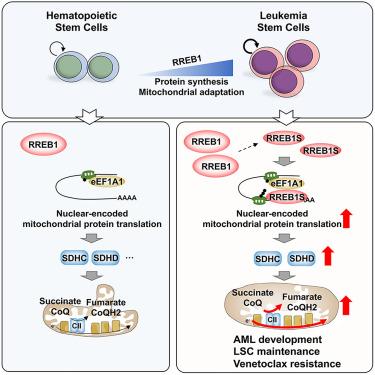当前位置:
X-MOL 学术
›
Cell Stem Cell
›
论文详情
Our official English website, www.x-mol.net, welcomes your
feedback! (Note: you will need to create a separate account there.)
Selective translation of nuclear mitochondrial respiratory proteins reprograms succinate metabolism in AML development and chemoresistance
Cell Stem Cell ( IF 19.8 ) Pub Date : 2024-10-01 , DOI: 10.1016/j.stem.2024.09.008 Guoqiang Han, Manman Cui, Pengbo Lu, Tiantian Zhang, Rong Yin, Jin Hu, Jihua Chai, Jing Wang, Kexin Gao, Weidong Liu, Shuxin Yao, Ziyan Cao, Yanbing Zheng, Wen Tian, Rongxia Guo, Min Shen, Zheming Liu, Weiming Li, Shanshan Zhao, Xiangpeng Lin, Yuhui Zhang, Kehan Song, Yan Sun, Fuling Zhou, Haojian Zhang
Cell Stem Cell ( IF 19.8 ) Pub Date : 2024-10-01 , DOI: 10.1016/j.stem.2024.09.008 Guoqiang Han, Manman Cui, Pengbo Lu, Tiantian Zhang, Rong Yin, Jin Hu, Jihua Chai, Jing Wang, Kexin Gao, Weidong Liu, Shuxin Yao, Ziyan Cao, Yanbing Zheng, Wen Tian, Rongxia Guo, Min Shen, Zheming Liu, Weiming Li, Shanshan Zhao, Xiangpeng Lin, Yuhui Zhang, Kehan Song, Yan Sun, Fuling Zhou, Haojian Zhang

|
Mitochondrial adaptations dynamically reprogram cellular bioenergetics and metabolism and confer key properties for human cancers. However, the selective regulation of these mitochondrial responses remains largely elusive. Here, inspired by a genetic screening in acute myeloid leukemia (AML), we identify RAS effector RREB1 as a translational regulator and uncover a unique translation control system for nuclear-encoded mitochondrial proteins in human cancers. RREB1 deletion reduces mitochondrial activities and succinate metabolism, thereby damaging leukemia stem cell (LSC) function and AML development. Replenishing complex II subunit SDHD rectifies these deficiencies. Notably, inhibition of complex II re-sensitizes AML cells to venetoclax treatment. Mechanistically, a short RREB1 variant binds to a conserved motif in the 3′ UTRs and cooperates with elongation factor eEF1A1 to enhance protein translation of nuclear-encoded mitochondrial mRNAs. Overall, our findings reveal a unique translation control mechanism for mitochondrial adaptations in AML pathogenesis and provide a potential strategy for targeting this vulnerability of LSCs.
中文翻译:

核线粒体呼吸蛋白的选择性翻译在 AML 发展和化疗耐药中重编程琥珀酸代谢
线粒体适应动态地重编程细胞生物能量学和新陈代谢,并赋予人类癌症关键特性。然而,这些线粒体反应的选择性调节在很大程度上仍然难以捉摸。在这里,受急性髓性白血病 (AML) 基因筛选的启发,我们将 RAS 效应子 RREB1 确定为翻译调节因子,并发现了人类癌症中核编码线粒体蛋白的独特翻译控制系统。RREB1 缺失会降低线粒体活性和琥珀酸代谢,从而损害白血病干细胞 (LSC) 功能和 AML 发展。补充复合物 II 亚基 SDHD 纠正了这些缺陷。值得注意的是,复合物 II 的抑制使 AML 细胞对维奈托克治疗重新敏感。从机制上讲,短 RREB1 变体与 3' UTR 中的保守基序结合,并与延伸因子 eEF1A1 合作以增强核编码的线粒体 mRNA 的蛋白质翻译。总体而言,我们的研究结果揭示了 AML 发病机制中线粒体适应的独特翻译控制机制,并为针对 LSC 的这种脆弱性提供了一种潜在的策略。
更新日期:2024-10-01
中文翻译:

核线粒体呼吸蛋白的选择性翻译在 AML 发展和化疗耐药中重编程琥珀酸代谢
线粒体适应动态地重编程细胞生物能量学和新陈代谢,并赋予人类癌症关键特性。然而,这些线粒体反应的选择性调节在很大程度上仍然难以捉摸。在这里,受急性髓性白血病 (AML) 基因筛选的启发,我们将 RAS 效应子 RREB1 确定为翻译调节因子,并发现了人类癌症中核编码线粒体蛋白的独特翻译控制系统。RREB1 缺失会降低线粒体活性和琥珀酸代谢,从而损害白血病干细胞 (LSC) 功能和 AML 发展。补充复合物 II 亚基 SDHD 纠正了这些缺陷。值得注意的是,复合物 II 的抑制使 AML 细胞对维奈托克治疗重新敏感。从机制上讲,短 RREB1 变体与 3' UTR 中的保守基序结合,并与延伸因子 eEF1A1 合作以增强核编码的线粒体 mRNA 的蛋白质翻译。总体而言,我们的研究结果揭示了 AML 发病机制中线粒体适应的独特翻译控制机制,并为针对 LSC 的这种脆弱性提供了一种潜在的策略。

































 京公网安备 11010802027423号
京公网安备 11010802027423号